 Double Oil Fried Rice, a seemingly ordinary yet uniquely charming home-cooked dish. The golden rice grains are distinct and glisten with a shiny oil coating, resembling glistening pearls. The special technique of using both vegetable oil and the aroma of spring onions thoroughly infuses every grain of rice, resulting in an irresistible aroma permeating the entire fried rice. When tasting this culinary delight, one can immediately experience the layers of texture and richness. The addition of lard creates a moist and tender rice, while the unique fragrance of onions blends harmoniously with the fragrance of the rice, leaving a lingering aftertaste. Each bite offers a combination of unique flavors and delicate textures that leave you craving for more.
Double Oil Fried Rice, a seemingly ordinary yet uniquely charming home-cooked dish. The golden rice grains are distinct and glisten with a shiny oil coating, resembling glistening pearls. The special technique of using both vegetable oil and the aroma of spring onions thoroughly infuses every grain of rice, resulting in an irresistible aroma permeating the entire fried rice. When tasting this culinary delight, one can immediately experience the layers of texture and richness. The addition of lard creates a moist and tender rice, while the unique fragrance of onions blends harmoniously with the fragrance of the rice, leaving a lingering aftertaste. Each bite offers a combination of unique flavors and delicate textures that leave you craving for more.
Ingredients for Double Oil Fried Rice:
| Rice | 300g |
| Streaky pork | 50g |
| Light soy sauce | 6g |
| Dark soy sauce | 3g |
| Oyster sauce | 3g |
| Ginger | 5g |
| Green onion | 5g |
| Scallion | 5g |
| Onion | 50g |
| Egg | 70g |
| Tricholoma Matsutake powder | 3g |
| Pepper powder | 3g |
| Shaoxing wine | 3g |
| Carrot | 30g |
Steps:
1.Firstly, rinse the rice thoroughly with clean water to remove impurities and starch. Next, add an appropriate amount of water to soak the rice completely. This will make the rice grains softer and result in a better texture when cooked. Then, pour the soaked rice and water into the pot of a rice cooker. Select the high heat setting to start cooking and wait for the water to come to a boil. Once the water is boiling, reduce the heat to medium-low and continue cooking until the water is completely evaporated and the rice becomes tender and flavorful. Finally, remove the steamed rice from the cooker and let it cool slightly in a bowl before using.
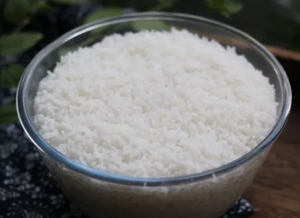
2.Prepare a piece of Streaky pork, which has unique patterns and rich fat content. We will handle it to achieve a better texture during cooking. Hold the streaky pork and separate the fatty part from the lean part. The fatty portion usually has more fat, which adds richness in flavor and texture to the dish. The lean part, on the other hand, is more tender and helps maintain the dish’s tenderness. Next, cut both the separated fatty and lean parts into small diced pieces. For the fatty part, you can choose to cut it slightly larger to preserve its unique texture and fat content. The lean part can be cut smaller, making it easier to absorb flavors during cooking. Carefully use a knife to evenly dice the fatty and lean parts. Ensure even and consistent cuts, resulting in neat and visually appealing diced pieces.
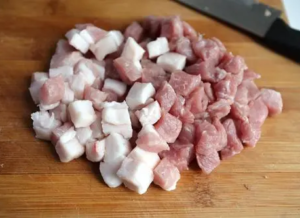
3.Now, pour the cooled steamed rice into a large bowl. This bowl should have enough space to easily mix and season the rice. Next, begin adding delicious flavors to the rice by drizzling two rounds of light soy sauce over the rice. Light soy sauce is a commonly used condiment that imparts rich saltiness and aroma to the rice. Then, add another round of dark soy sauce. Dark soy sauce has a deeper color and richer flavor, which gives the rice an enticing reddish-brown appearance and adds a unique taste. Next, add a spoonful of oyster sauce. Oyster sauce is a flavorful seasoning that brings extra smoothness and aroma to the rice. Sprinkle a moderate amount of Tricholoma Matsutake powder. Tricholoma Matsutake powder is derived from dried Tricholoma matsutake and has a distinctive aroma and umami taste, adding a touch of luxury to the rice. Finally, sprinkle a pinch of pepper powder. Pepper powder adds a subtle spiciness to the rice, enhancing the overall flavor profile. Now, using chopsticks, mix all the seasonings evenly into the rice, ensuring that each grain absorbs and melds with these delicious flavors. With these seasonings, the rice is now ready. It will exude an enticing aroma and possess a rich layer of flavors.
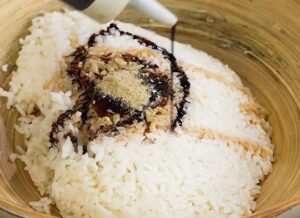
4.Heat the pan over high heat without adding any oil. Then, pour the diced fatty pork into the pan. Stir-fry the fatty pork, and you will see the luscious pork fat gradually being released. Stir-fry the fatty pork evenly, allowing it to heat up uniformly. You’ll notice that the fatty pork turns slightly golden brown and emits an enticing aroma. During this process, the flavor of the pork fat will also enhance further. Next, slice a piece of ginger and two sections of green onions. Add them to the pan along with a moderate amount of huadiao wine. This helps to remove any unpleasant smell from the fatty pork and adds fragrance to the pork fat. Continue gently stir-frying, ensuring that the fatty pork combines well with the ginger, scallions, and huadiao wine. When the fatty pork turns golden brown, it indicates that it has been cooked to the right degree. At this point, use a slotted spoon to remove the fatty pork, ginger, scallions, and any other impurities, leaving only the rendered pork fat in the pan. Removing these impurities will make the final dish cleaner and more delicious.
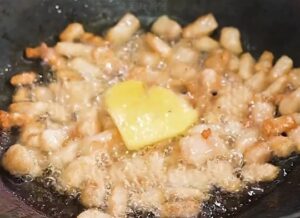
5.After removing the residue, dice an onion and add it to the pan. Stir-fry the onion over medium heat until it becomes translucent. This releases the aroma and sweetness of the onion. Then, pour the diced lean pork into the pan and stir-fry it together with the onion. Continue cooking over medium heat until the lean pork slightly changes color. Now, add the cooled steamed rice to the pan and mix it with the sautéed onion and lean pork. Gently stir-fry to ensure all ingredients are well combined. Next, crack an egg into the pan and continue stirring, allowing the egg to distribute evenly and mix thoroughly with the rice, onion, and lean pork. This step adds texture and richness to the dish. Keep stir-frying over medium-low heat until the rice is fully incorporated with the other ingredients and the fried rice becomes piping hot. Make sure all the ingredients are evenly heated, resulting in a more delicious dish.
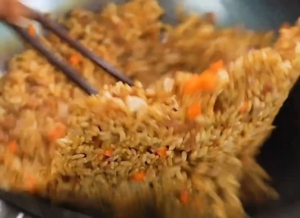
6.As the fried rice is nearing completion, we can further enhance its color and texture. Cut carrots into small cubes, which will bring a refreshing sweetness and crisp texture to the fried rice. Additionally, finely chop some scallions, which not only add vibrant color to the dish but also impart a subtle aroma to the fried rice. Sprinkle the chopped scallions on top of the fried rice, making the entire dish more enticing. Then, stir-fry the carrot cubes and scallions together with the rice, ensuring that they are evenly distributed throughout the fried rice, so that every bite incorporates their delicious flavors. Once all the ingredients are thoroughly mixed and the fried rice is completely heated through, you can transfer it from the pan onto a serving plate. Now, you can enjoy this fragrant, visually appealing, and flavorful fried rice.
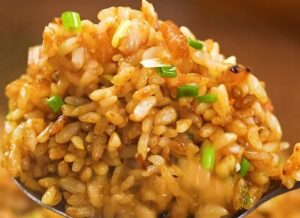
Tips:
1.It is best to use cooled leftover rice to make double-oil fried rice. The moisture in the cooled rice has evaporated, which helps prevent the fried rice from becoming too soggy. If you don’t have leftover rice, you can cool freshly cooked rice or refrigerate it for a while before using it.
2.Stir-frying fried rice requires high heat and quick cooking, but it’s also important to control the cooking time. The oil should be heated until it reaches a smoking point before adding the ingredients for quick stir-frying. Avoid overcooking to prevent the rice from becoming sticky. When stir-frying, ensure that the ingredients and oil are quickly and evenly combined.
Double Oil Fried Rice is a delicious and nutritious home-cooked dish. The golden-colored rice is thoroughly infused with the aroma of pork fat and onions, resembling stars scattered on a plate. The richness of rapeseed oil and the unique taste of scallions blend together, bringing delightful enjoyment to every bite. Double-oil fried rice offers a varied texture and flavor. The smoothness of the pork fat and the distinct fragrance of the onions make the rice more delicious. When tasting it, you first experience the refreshing aroma of the onions, followed by the rich flavor of the pork fat, and finally, the natural fragrance of the rice. These three elements blend perfectly, creating an enchanting sensation.
